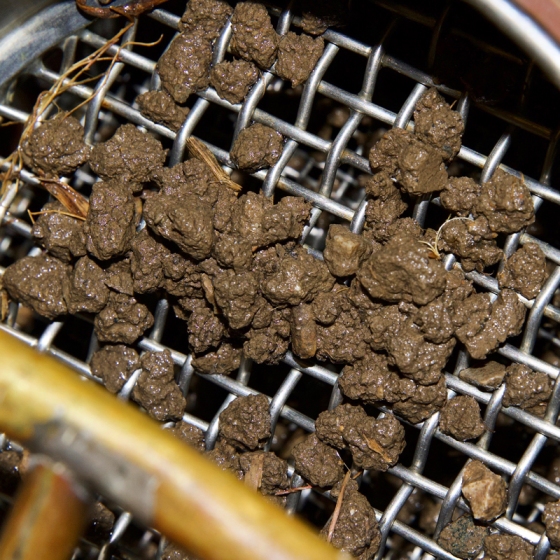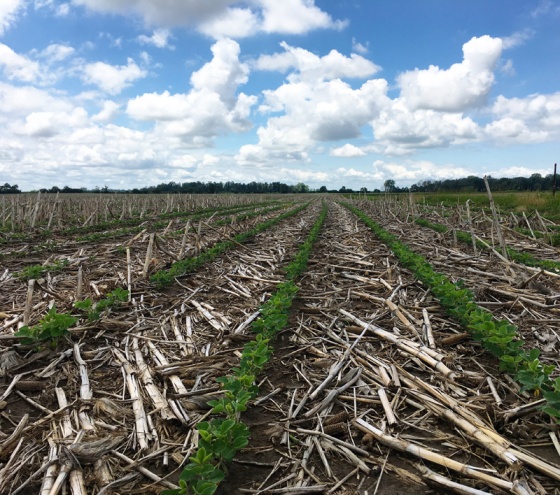The ground beneath your feet might seem like a uniform material, but it’s really a mixture of soil particles, organic matter, and other mineral/organic components. For a soil to be healthy, it must have good structure. Soil is made up of a combination of primary particles - sand, silt and clay. These particles can be bound together into what soil scientists call “aggregates.”

Soil aggregates retained on a 4.75 mm sieve after wet sieving experiment. Credit: Nall Moonilall
These aggregates are clumps of soil that range from the micro level (less than 0.25mm in diameter) to the macro level (greater than 0.25mm in diameter). Furthermore, they can resemble various shapes: granular, blocky, etc. These varied shapes allow for healthy soil to have pores spaces for air and water, needed for healthy plant growth.
Aggregate formation is a complex process. Soil aggregates are formed through physical, chemical and biological activity below ground. They are even influenced by human factors, like tilling, walking on the surface, or even how you fertilize your garden. Formation of aggregates begins with finer soil primary particles binding together. You may know that clay particles have a negative charge. And, the fertilizers you use include salts that have positively charged cations (things like potassium nitrate, etc.) The positively charged cations allow the negatively charged clay particles to bind together creating “floccules.” The type and amount of clay minerals in the soil often plays an influential role in aggregation formation.

Soil crust formation on a soil exposed to simulated rainfall. You can see the crust formation on the surface of the soil as well as how deep the crust extends. (This really is soil - not cement!) Credit: Nall Moonilall
The second part of aggregate formation deals with cementation. Here, the clay floccules and other soil particles are bonded together by some type of cementing agent. (Here we mean "binding" - not cement like in concrete!) Examples of cementing agents include organic matter, and liming materials like calcium carbonate. Even types of oxides, like iron and aluminum can help cement particles together.
In the case of organic matter, it is broken down by the soil microorganisms and soil fauna (earthworms, etc.) When breakdown occurs, these organisms secrete organic compounds that are the “glue” that makes cementation occur. Plant roots also play a role in aggregate formation by secreting organic compounds called root exudates. These help bind soil together near the root zone. Fungal hyphae also contribute to aggregate formation by entangling and weaving around soil particles.
As you can see, aggregate formation is the result of many interactions and feedback loops occurring below ground.
Soil aggregates play a major role in soil structure formation and soil health. In agriculture, the stability of aggregates is critical to how well an agroecosystem will function. The pore spaces in soil influence air and water storage, and gaseous exchange. They create habitat for soil microorganisms, and allow for plant root development and penetration. They also assist in nutrient cycling and transport.
Soils that have high aggregate stability are less susceptible to erosion. They hold their shape when exposed to disruptive forces, like water, and do not easily break apart.

Keep soil covered! Crop residues on the soil surface help to protect soil from erosive forces. Credit: Nall Moonilall
Poorly aggregated soils disintegrate easily when exposed to erosive forces. They tend to breakdown faster, leading to soil degradation. Poor stability can lead to pore spaces being filled in and can ultimately result in the formation of soil crusts. This can lead to reduced infiltration and gaseous exchange. Poorly aggregated soils can reduce crop productivity.
Soil management often influences aggregate size, shape, and stability. Favorable practices that promote and maintain greater stability include:
To recap – soil aggregates are the building blocks that make up soil and their stability is extremely important in the long-term. Soils that are well aggregated exhibit greater soil health, ensure greater agronomic productivity, are less susceptible to soil erosion, and can play a role in carbon sequestration.
Answered by Nall I. Moonilall, Ohio State University
|
Monday, July 22, 2019
WHAT IS A SOIL AGGREGATE
This is a copy and paste posting from "Soil Matter, Get The Scoop" blog. It's informative and pretty complete on the subject of soil aggregates, their value to us in the farming game, and suggested management for developing and maintaining these aggregates. This post starts out with the question of what are soil aggregates, and the reply is by Nall I. Moonilall of Ohio State.
Subscribe to:
Post Comments (Atom)
No comments:
Post a Comment